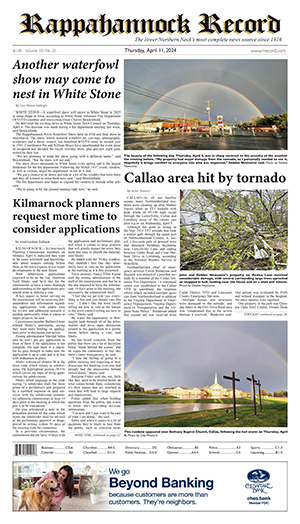by Henry Lane Hull
[dropcap]T[/dropcap]he 1972 hurricane season saw several severe storms affect the Northern Neck, the most telling of which was Hurricane Agnes on June 14. The force of the storm brought down many trees and tore up numerous roads across the region. One lasting result was the loss of a long wooden bridge on Courthouse Road near the Howland Chapel School south of Heathsville.
Although not a classic covered bridge, the structure was quite picturesque and evoked nostalgia for a bygone era. The bridge crossed a marshland that flushed the waters of what a short hop away became the headwaters of the Great Wicomico River. The bridge collapsed in the force of the hurricane, leaving many folks in the area handicapped in getting to and from Heathsville, as well as saddened by its disappearance.
In those days environmental concerns did not hold the sway that they do today and unfortunately VDOT decided to haul in hundreds of truckloads of filler material to build a road where the bridge once stood, leaving only a couple of culverts to drain the swamp west of the newly constructed road.
The ensuing situation over the last 45 years has proven to be a case study in how not to treat wetlands. Today most people recognize the value of wetlands as repositories for run-off water, thereby preventing greater erosion of upland areas. Back then such basic knowledge was not considered significant in planning.
The work filling in the wetlands to allow for the new road to be constructed required over a year to complete. The bucolic scene lost much of its charm, but more importantly the site clearly proved to be a disaster waiting to happen. Hurricane Michael manifested the accuracy of that expectation.
The storm tore apart the fill dirt that had been used to replace the bridge, as the culverts proved to be completely inadequate to sustain the pressure caused by the water and the wind. At present a huge expanse of the elevated manmade roadway, as long as the length of the former wooden bridge, has disappeared, thus bringing about the reunification of the formerly divided two sections of the marshland. Fortunately, no one was injured in the washout and the community now faces another prolonged inconvenience of having to drive extra miles to get around the gaping hole.
Wetlands serve a worthy purpose in allowing flowing waters from storms to find repositories until they can be absorbed or ultimately run off to larger bodies of water. When we choose to ignore or downplay their value, in the end we will pay a price for such negligence.
I once heard a public official say that tidal wetlands were the only ones of concern and that non-tidal ones could be manipulated however the authorities wished. Fortunately, that opinion no longer holds sway. Both tidal and non-tidal wetlands are ecologically necessary in adhering to best management practices. We ignore them at our own peril.
One of the worst assaults on wetlands preservation has been the introduction of Tulloch Ditching, a practice whereby wetlands can be drained by digging deep draining ditches that thereby allow for alternate uses of the former marshlands. Allegedly, Tulloch Ditching is supposed to be offset by establishing alternative wetlands, which often do not serve the intended purpose, reinforcing the traditional view that Mother Nature knows best.
Perhaps the Northern Neck’s most vociferous opponent of Tulloch Ditching was the late Fred Ajootian of White Stone, who served for decades on the Lancaster County Wetlands Board. Fred, a trained engineer, warned that the practice would lead to future catastrophes requiring major expenditures to correct.
Careful and effective management of all wetlands is vital, especially in coastal areas. One only can hope that VDOT will learn from the disastrous Courthouse Road experience and this time re-install a bridge that will free the wetlands to “do their own thing.”











